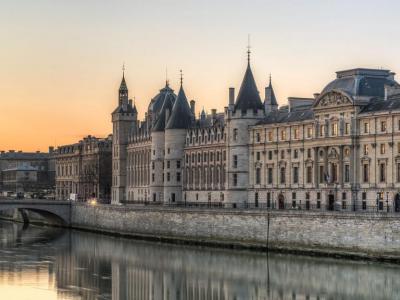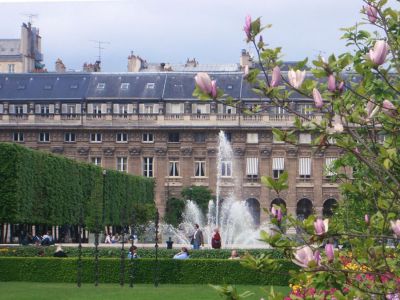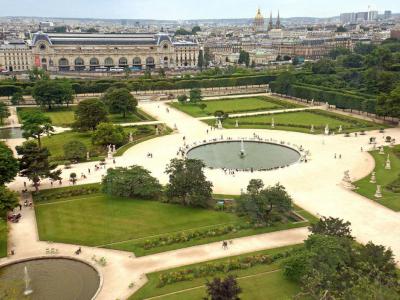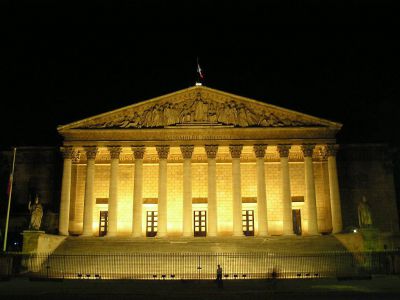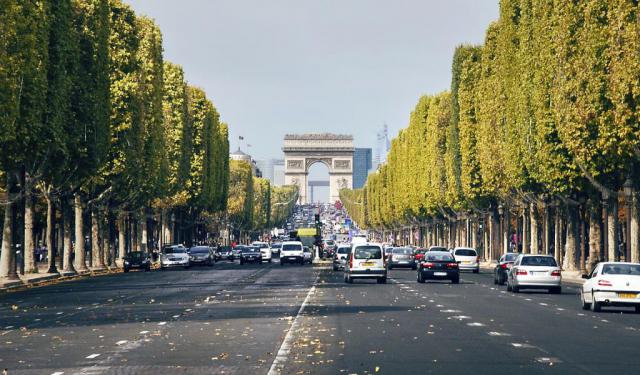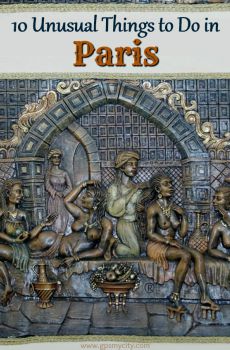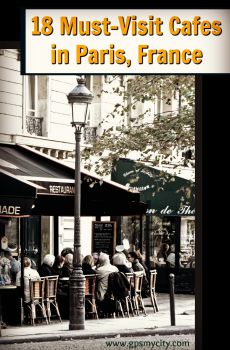
The French Revolution Landmarks Walking Tour (Self Guided), Paris
The French Revolution had a huge impact on France's history as it gave rise to a radical democratic republic and resulted in quite a bit of violence during the infamous "Reign of Terror". Even though many of Paris’ buildings were damaged in the course of the bloody conflicts, the sites they occupied – which you can find on this self-guided tour – are of a great historical value today.
Lots of lives were lost during the Revolution, and some locals argue that the recently renovated Place de la Bastille monument – built on top of a forbidding state prison that was stormed and then levelled by the people in the name of liberty – represents the need of build a more peaceful society.
Certainly, the Conciergerie is an interesting building with quite a long, dark and intriguing history of its own. Dating to the early Middle Ages, it was part of the Palais de la Cité, but became rather infamous during the Revolution, serving as a place of imprisonment and execution. Its location on the waterfront, however, gives the impression of an enchanted castle with towers and spires.
You will also get to see the Tuileries Gardens – designed by the same architect who landscaped those of Versailles, as well as Les Invalides, which played a crucial role in the Revolution as the rioters stole the cannons and muskets stored in its cellars to use for storming the Bastille.
Follow our self-guided walking tour to appreciate the major landmarks during this tumultuous period in French history!
Lots of lives were lost during the Revolution, and some locals argue that the recently renovated Place de la Bastille monument – built on top of a forbidding state prison that was stormed and then levelled by the people in the name of liberty – represents the need of build a more peaceful society.
Certainly, the Conciergerie is an interesting building with quite a long, dark and intriguing history of its own. Dating to the early Middle Ages, it was part of the Palais de la Cité, but became rather infamous during the Revolution, serving as a place of imprisonment and execution. Its location on the waterfront, however, gives the impression of an enchanted castle with towers and spires.
You will also get to see the Tuileries Gardens – designed by the same architect who landscaped those of Versailles, as well as Les Invalides, which played a crucial role in the Revolution as the rioters stole the cannons and muskets stored in its cellars to use for storming the Bastille.
Follow our self-guided walking tour to appreciate the major landmarks during this tumultuous period in French history!
How it works: Download the app "GPSmyCity: Walks in 1K+ Cities" from Apple App Store or Google Play Store to your mobile phone or tablet. The app turns your mobile device into a personal tour guide and its built-in GPS navigation functions guide you from one tour stop to next. The app works offline, so no data plan is needed when traveling abroad.
The French Revolution Landmarks Walking Tour Map
Guide Name: The French Revolution Landmarks Walking Tour
Guide Location: France » Paris (See other walking tours in Paris)
Guide Type: Self-guided Walking Tour (Sightseeing)
# of Attractions: 9
Tour Duration: 3 Hour(s)
Travel Distance: 7.3 Km or 4.5 Miles
Author: karen
Sight(s) Featured in This Guide:
Guide Location: France » Paris (See other walking tours in Paris)
Guide Type: Self-guided Walking Tour (Sightseeing)
# of Attractions: 9
Tour Duration: 3 Hour(s)
Travel Distance: 7.3 Km or 4.5 Miles
Author: karen
Sight(s) Featured in This Guide:
- Place de la Bastille (Bastille Square)
- Hotel de Ville (City Hall)
- La Conciergerie (The Lodge)
- Palais-Royal (Royal Palace)
- Pavillon de Flore (Pavilion of Flora)
- Jardin des Tuileries (Tuileries Garden)
- Place de la Concorde (Concorde Square)
- Assemblee Nationale (National Assembly)
- Hotel des Invalides (House of The Invalids)
1) Place de la Bastille (Bastille Square)
Bastille Square in Paris is what's left now of the once infamous fortress-turned-prison that stood in this place in the late 18th century. Initially reserved exclusively for the upper-class inmates, gradually this prison started to accommodate commoners, as well, although in the far less comfortable conditions than those afforded to the aristocracy, for which reason it acquired a bad reputation and was hated and feared, all at once.
On July 14, 1789, the prison-fortress was stormed by a crowd of angry and armed people, upon which the prison governor first issued a ceasefire note, but then had to surrender and open the gates, seeing all the inmates liberated, thus marking the outset of the French Revolution. It was just a matter of days, after the storming, that a building contractor was hired for the demolition of the Bastille which, by November of the same year, was totally gone.
Now called Place de la Bastille, this square was established to commemorate those revolutionary events and to celebrate victory of democracy over tyranny. Special pavement stones here mark the original site of the fortress. The imposing July Column monument, dominating the square, commemorates another revolution – of 1830 – that lasted three days and saw hundreds of people die and resulting in King Charles X being replaced by King Louis-Philippe.
Why You Should Visit:
Centrally located, Bastille Square is perpetually busy. Adding to its popularity is also the near presence of the river Seine overlooking which are a number of benches, ideal for a quick stopover and having a bite while observing the surroundings – something the tourists quite like to do, actually.
Tip:
There are also short river cruises running along the canal from the Bassin de l’Arsenal, passing through tunnels underneath the old foundations of the Bastille fortress and contemporary square, then re-emerging and passing through several locks before reaching the Bassin de la Villette, which is altogether quite an exciting way to see Paris from a different perspective!
On July 14, 1789, the prison-fortress was stormed by a crowd of angry and armed people, upon which the prison governor first issued a ceasefire note, but then had to surrender and open the gates, seeing all the inmates liberated, thus marking the outset of the French Revolution. It was just a matter of days, after the storming, that a building contractor was hired for the demolition of the Bastille which, by November of the same year, was totally gone.
Now called Place de la Bastille, this square was established to commemorate those revolutionary events and to celebrate victory of democracy over tyranny. Special pavement stones here mark the original site of the fortress. The imposing July Column monument, dominating the square, commemorates another revolution – of 1830 – that lasted three days and saw hundreds of people die and resulting in King Charles X being replaced by King Louis-Philippe.
Why You Should Visit:
Centrally located, Bastille Square is perpetually busy. Adding to its popularity is also the near presence of the river Seine overlooking which are a number of benches, ideal for a quick stopover and having a bite while observing the surroundings – something the tourists quite like to do, actually.
Tip:
There are also short river cruises running along the canal from the Bassin de l’Arsenal, passing through tunnels underneath the old foundations of the Bastille fortress and contemporary square, then re-emerging and passing through several locks before reaching the Bassin de la Villette, which is altogether quite an exciting way to see Paris from a different perspective!
2) Hotel de Ville (City Hall)
The City Hall of Paris, overlooking its namesake square, is the largest city hall building in Europe. Historically central to Parisian life, this location has been the city’s administrative hub since 1357 when the provost of merchants purchased the site intending to make it a public gathering space. Curiously enough, the early sessions of the Paris municipal council were held at the home of a city mayor – the practice continued until the 16th century when King Francis I ordered a purpose-built edifice for that. The Renaissance-style building's south wing was commissioned in 1535. Later, it was joined by the north wing, in 1605, under Henry IV and Louis XIII.
As the French Revolution headquarters, the City Hall accommodated Maximilien Robespierre and his supporters. Ironically, it was here that Robespierre himself was arrested in 1794, at the end of the infamous Rule of Terror period, during which anyone opposing the revolution was sent to the guillotine.
In 1835, the building was expanded to accommodate the growing city government. However, during the Franco-Prussian War and the Paris Commune, it once again became a stage for political upheaval, culminating in its near-total destruction. During the final days of the Paris Commune, when their defeat was imminent and the French army closed in on the building then used as the Paris Commune headquarters, the Communards set it ablaze, completely destroying everything inside, including the city archives.
Reconstruction between 1874 and 1882 adhered to the original Renaissance-style exterior, while the interior had to be created anew, including lavish ceremonial rooms decorated with murals by noted artists. The façade featured 108 statues by prominent sculptors, including Auguste Rodin, who created the likenesses of famous Parisians such as philosophers Voltaire and Jean-Jacques Rousseau, writer Charles Perrault (author of "The Sleeping Beauty", "Little Red Riding Hood", and "Cinderella"), sculptor Jean-Baptiste Pigalle, and many others. Another thirty statues here represent French cities. The clock at the central tower is also adorned with statues – several female sculptures depicting the river Seine, the city of Paris, the “Work,” and the “Education”.
In the 20th century, the City Hall witnessed Charles de Gaulle’s Liberation speech in 1944. In recent years, the Mayor of Paris opened the building to public events including the annual White Night festival. The City Hall also played a role in the 2024 Olympics, hosting the start of the marathon.
While public access to the City Hall is generally restricted, there are two rooms in the building constantly allocated to art exhibitions: one for photography, and one for art in general. Also, there are almost always some cultural events taking place outside, in the square in front of the building.
As the French Revolution headquarters, the City Hall accommodated Maximilien Robespierre and his supporters. Ironically, it was here that Robespierre himself was arrested in 1794, at the end of the infamous Rule of Terror period, during which anyone opposing the revolution was sent to the guillotine.
In 1835, the building was expanded to accommodate the growing city government. However, during the Franco-Prussian War and the Paris Commune, it once again became a stage for political upheaval, culminating in its near-total destruction. During the final days of the Paris Commune, when their defeat was imminent and the French army closed in on the building then used as the Paris Commune headquarters, the Communards set it ablaze, completely destroying everything inside, including the city archives.
Reconstruction between 1874 and 1882 adhered to the original Renaissance-style exterior, while the interior had to be created anew, including lavish ceremonial rooms decorated with murals by noted artists. The façade featured 108 statues by prominent sculptors, including Auguste Rodin, who created the likenesses of famous Parisians such as philosophers Voltaire and Jean-Jacques Rousseau, writer Charles Perrault (author of "The Sleeping Beauty", "Little Red Riding Hood", and "Cinderella"), sculptor Jean-Baptiste Pigalle, and many others. Another thirty statues here represent French cities. The clock at the central tower is also adorned with statues – several female sculptures depicting the river Seine, the city of Paris, the “Work,” and the “Education”.
In the 20th century, the City Hall witnessed Charles de Gaulle’s Liberation speech in 1944. In recent years, the Mayor of Paris opened the building to public events including the annual White Night festival. The City Hall also played a role in the 2024 Olympics, hosting the start of the marathon.
While public access to the City Hall is generally restricted, there are two rooms in the building constantly allocated to art exhibitions: one for photography, and one for art in general. Also, there are almost always some cultural events taking place outside, in the square in front of the building.
3) La Conciergerie (The Lodge)
The Conciergerie, or The Lodge, is a historic courthouse and prison on the City Island in Paris, originally part of the royal City Palace, which also includes the Holy Chapel and Paris's first public clock, installed around 1370. Once a royal residence and judicial hub, this part of the City Palace became known as the Conciergerie after the “concierge” who was appointed by the king to uphold order.
By 1391, the Conciergerie was designated as a jail for both common criminals and political prisoners, in which living conditions reflected the prisoners' wealth and social status. Affluent inmates could secure private cells with basic comforts, while the poorest were confined to dark, cramped dungeons. Executions were routine, with many prisoners sentenced by the Revolutionary Tribunal and taken to the nearby guillotine at Concorde Square.
The Conciergerie gained notoriety during the French Revolution’s Reign of Terror, when it held over 2,700 prisoners, including prominent figures like Marie Antoinette, the last queen consort of France, and Georges Danton, a leading figure in the French Revolution. Both of them were tried and executed by guillotine. The prison’s influence continued beyond the Revolution, with various regimes utilizing its facilities, including the trial of Napoleon III.
The Conciergerie’s architectural significance lies in its four medieval towers, such as the Clock Tower, home to the first public clock in Paris, and the grand Hall of the Men-at-Arms.
Today, the Conciergerie is a national monument and museum, offering visitors an immersive look at its turbulent history. Marie Antoinette’s cell has been transformed into a Memorial Chapel, and the Women’s courtyard offers a glimpse into the site’s somber past. For a more detailed experience, visitors can use the "Histopad" gadget, combining audio and visual elements, to learn more about life inside the prison during its most infamous periods.
Tip:
Visiting the Conciergerie is possible on a combined ticket granting access to the neighboring Holy Chapel as well.
By 1391, the Conciergerie was designated as a jail for both common criminals and political prisoners, in which living conditions reflected the prisoners' wealth and social status. Affluent inmates could secure private cells with basic comforts, while the poorest were confined to dark, cramped dungeons. Executions were routine, with many prisoners sentenced by the Revolutionary Tribunal and taken to the nearby guillotine at Concorde Square.
The Conciergerie gained notoriety during the French Revolution’s Reign of Terror, when it held over 2,700 prisoners, including prominent figures like Marie Antoinette, the last queen consort of France, and Georges Danton, a leading figure in the French Revolution. Both of them were tried and executed by guillotine. The prison’s influence continued beyond the Revolution, with various regimes utilizing its facilities, including the trial of Napoleon III.
The Conciergerie’s architectural significance lies in its four medieval towers, such as the Clock Tower, home to the first public clock in Paris, and the grand Hall of the Men-at-Arms.
Today, the Conciergerie is a national monument and museum, offering visitors an immersive look at its turbulent history. Marie Antoinette’s cell has been transformed into a Memorial Chapel, and the Women’s courtyard offers a glimpse into the site’s somber past. For a more detailed experience, visitors can use the "Histopad" gadget, combining audio and visual elements, to learn more about life inside the prison during its most infamous periods.
Tip:
Visiting the Conciergerie is possible on a combined ticket granting access to the neighboring Holy Chapel as well.
4) Palais-Royal (Royal Palace)
Palais-Royal, originally named Palais-Cardinal, was constructed by Richelieu in 1628 and later inherited by King Louis XIII after his death. Although Louis XIV briefly lived here as a child, he found the experience traumatizing due to a late-night escape from potential revolters, which may have been one of the reasons why he chose to reside outside of Paris, in Versailles, later in life.
On 12 July 1789, a journalist and politician of the time named Camille Desmoulins gave a speech on a table in the garden of Palais-Royal. Fearing that King Louis would take action against the Third Estate after dismissing finance minister Jacques Necker, Desmoulins called for a popular uprising, which led to the storming of the Bastille two days later.
During the 19th century, the notorious King Louis-Philippe transformed the palace into a shopping and entertainment destination. Despite the dirty surrounding streets, visitors could clean their muddy shoes before entering the complex to shop, browse, and socialize. As the property was privately owned, police intervention was not permitted, leading to the emergence of gambling and prostitution at night.
The square today is adorned with the playful addition of black and white striped columns by Daniel Buren. Constructed in 1985 and made of white and black Pyrenees marble, these columns were met with mixed feelings from the public, both loved and hated. Despite their different heights, they are set in straight lines at even spaces, maintaining a sense of uniformity.
Why You Should Visit:
A little seclusion in a busy part of town that really transports you to a different place and time – imagining what court life must have been like. Ideal for a day/night walk (much more beautiful by night).
Tip:
Consider visiting to the charming rose garden (8am-8:30pm) located to the left of the palace, by the courtyard. Designed in 1633, it was transformed into a popular and remarkable floral haven in 1992. There are benches to sit on and admire the flowers, as well as a statue of a snake charmer by Adolphe Martial Thabard (1875). During lunchtime, workers often come here to relax and enjoy mini-picnics with pastries and takeaway coffees. Visitors can pull up one of the scattered metal chairs by the central fountain, bring a book, and unwind.
On 12 July 1789, a journalist and politician of the time named Camille Desmoulins gave a speech on a table in the garden of Palais-Royal. Fearing that King Louis would take action against the Third Estate after dismissing finance minister Jacques Necker, Desmoulins called for a popular uprising, which led to the storming of the Bastille two days later.
During the 19th century, the notorious King Louis-Philippe transformed the palace into a shopping and entertainment destination. Despite the dirty surrounding streets, visitors could clean their muddy shoes before entering the complex to shop, browse, and socialize. As the property was privately owned, police intervention was not permitted, leading to the emergence of gambling and prostitution at night.
The square today is adorned with the playful addition of black and white striped columns by Daniel Buren. Constructed in 1985 and made of white and black Pyrenees marble, these columns were met with mixed feelings from the public, both loved and hated. Despite their different heights, they are set in straight lines at even spaces, maintaining a sense of uniformity.
Why You Should Visit:
A little seclusion in a busy part of town that really transports you to a different place and time – imagining what court life must have been like. Ideal for a day/night walk (much more beautiful by night).
Tip:
Consider visiting to the charming rose garden (8am-8:30pm) located to the left of the palace, by the courtyard. Designed in 1633, it was transformed into a popular and remarkable floral haven in 1992. There are benches to sit on and admire the flowers, as well as a statue of a snake charmer by Adolphe Martial Thabard (1875). During lunchtime, workers often come here to relax and enjoy mini-picnics with pastries and takeaway coffees. Visitors can pull up one of the scattered metal chairs by the central fountain, bring a book, and unwind.
5) Pavillon de Flore (Pavilion of Flora)
The Pavillon de Flore, situated at the southwest end of the Louvre Palace by the banks of the Seine, was named after the sculpture group "The Triumph of Flora" carved by Jean-Baptiste Carpeaux (1827-1875) that faces the Pont Royal. Flora is the mythological goddess of flowering plants and also inspired the name of the famous Café de Flore. This pavilion was constructed in 1607 during the reign of Henry IV and extended the Grande Galerie that formed the south face of the Palais du Louvre to the Palais des Tuileries, linking the two palaces.
During the French Revolution, the Pavillon de Flore was renamed Pavillon de l'Égalité (House of Equality) and became the meeting point for several committees of the period, including the most famous one, the Committee of Public Safety. Many other committees of the Revolutionary Government occupied the Palais des Tuileries, referred to by contemporaries as the Palace of the Nation, during the time of the National Convention. Notable occupiers included the Monetary Committee and the Account and Liquidation Examination Committee; however, the most famous was the Committee of Public Safety.
While the interior rooms of the Pavillon de Flore are not open to the public, collections from Africa, Asia, Oceana, and the Americas are housed in the adjoining Denon Galleries. Enjoy your visit!
During the French Revolution, the Pavillon de Flore was renamed Pavillon de l'Égalité (House of Equality) and became the meeting point for several committees of the period, including the most famous one, the Committee of Public Safety. Many other committees of the Revolutionary Government occupied the Palais des Tuileries, referred to by contemporaries as the Palace of the Nation, during the time of the National Convention. Notable occupiers included the Monetary Committee and the Account and Liquidation Examination Committee; however, the most famous was the Committee of Public Safety.
While the interior rooms of the Pavillon de Flore are not open to the public, collections from Africa, Asia, Oceana, and the Americas are housed in the adjoining Denon Galleries. Enjoy your visit!
6) Jardin des Tuileries (Tuileries Garden) (must see)
Centermost of all the Paris city parks, the Tuileries Garden forms part of the triumphal axis (the so-called "Grand Axe") stretching from La Défense plaza all the way to the Louvre. The garden is almost totally flat and has a circular fountain in the middle, which is most popular in summer.
Originally, this Italian Renaissance-style garden was created for Queen Catherine de Médici, who in the 16th century began construction of a palace just outside the western walls of the capital. The garden took the name of the tile factories (called "tuileries") that it replaced. First opened to the public in 1667, it became fully accessible only after the French Revolution.
In 1789, following the fall of the Bastille, King Louis XVI and his wife, Marie Antoinette, moved into the Tuileries Palace as a publicity stunt to get "closer to the people". Sadly, this stunt eventually produced the undesired effect and resulted in the royal family being locked up in the palace under house arrest. Three years later, the palace came under attack in what proved to be the defining moment of the Revolution. The French monarchy was abolished, and quite radically so, with the help of the then newly-invented guillotine installed in the nearby Concorde Square. The last words of the king rising to the scaffold were: "Gentlemen, I am innocent of everything of which I am accused. I hope that my blood may cement the good fortune of the French."
In the 19th century, Napoleon merged the Tuileries with the Louvre in a bid to create one huge super-palace complex. The project was barely completed when the bloody uprising of the Paris Commune in 1871 saw the former royal Tuileries Palace set on fire and completely destroyed. But the palace garden survived and to date retains the general outline of its original master plan.
In the 1990s, the landscape was renewed as part of the Grand Louvre project. Now free to access, the park is an oasis of calm amid the bustle of Paris. At visitors' disposal are a good number of green chairs to sit on and enjoy ice cream or drinks, plus a pond with small rented boats, from which one can enjoy a marvelous view of the Eiffel Tower or simply unwind to the chirp of the local birds.
Originally, this Italian Renaissance-style garden was created for Queen Catherine de Médici, who in the 16th century began construction of a palace just outside the western walls of the capital. The garden took the name of the tile factories (called "tuileries") that it replaced. First opened to the public in 1667, it became fully accessible only after the French Revolution.
In 1789, following the fall of the Bastille, King Louis XVI and his wife, Marie Antoinette, moved into the Tuileries Palace as a publicity stunt to get "closer to the people". Sadly, this stunt eventually produced the undesired effect and resulted in the royal family being locked up in the palace under house arrest. Three years later, the palace came under attack in what proved to be the defining moment of the Revolution. The French monarchy was abolished, and quite radically so, with the help of the then newly-invented guillotine installed in the nearby Concorde Square. The last words of the king rising to the scaffold were: "Gentlemen, I am innocent of everything of which I am accused. I hope that my blood may cement the good fortune of the French."
In the 19th century, Napoleon merged the Tuileries with the Louvre in a bid to create one huge super-palace complex. The project was barely completed when the bloody uprising of the Paris Commune in 1871 saw the former royal Tuileries Palace set on fire and completely destroyed. But the palace garden survived and to date retains the general outline of its original master plan.
In the 1990s, the landscape was renewed as part of the Grand Louvre project. Now free to access, the park is an oasis of calm amid the bustle of Paris. At visitors' disposal are a good number of green chairs to sit on and enjoy ice cream or drinks, plus a pond with small rented boats, from which one can enjoy a marvelous view of the Eiffel Tower or simply unwind to the chirp of the local birds.
7) Place de la Concorde (Concorde Square)
Concord Square is Paris's largest public square, spanning 7.6 hectares at the eastern end of the Champs-Élysées. It was created in the mid-18th century to honor King Louis XV’s recovery. The square's octagonal layout, surrounded by moats and stone bridges, originally featured the equestrian statue of Louis XV at its center.
During the French Revolution, the square gained historical significance as the site of numerous public executions including those of King Louis XVI, Queen Marie Antoinette, and Maximilien Robespierre, one of the most influential and controversial French revolutionary figures. The installed guillotine remained particularly busy throughout the so-called "Reign of Terror" in the summer of 1794 when in a single month more than 1,300 people were executed. Renamed Revolution Square during this period, it was rechristened Concord Square in 1795, symbolizing peace in post-revolutionary France.
Today, the square is home to iconic landmarks. The Luxor Obelisk, a gift from Egypt, was raised there in 1836. In 1998, it was capped with a gold-leaf top. Aged over 3,000 years, this is by far the most ancient monument in Paris, originally standing at Luxor Temple’s entrance. The 230-ton obelisk is complemented by two fountains: the Maritime Fountain, symbolizing France’s seas, and the Fluvial Fountain, representing its rivers. The square’s Neoclassical buildings house important institutions like the former headquarters of the French Navy. In continuation of the nautical theme, there are 20 rostral columns throughout the square adorned with a ship prow which is part of the official Paris emblem.
On its eastern side, the Tuileries Garden connects with museums like the “Game of Palm” National Gallery (a former tennis court turned into an art gallery) and the Orangery, home to Monet’s Water Lilies painting.
Concord Square continues to host significant events, including Bastille Day parades and, more recently, Olympic celebrations. In 2021, plans were announced to make the square more pedestrian-friendly by reducing traffic, adding green spaces, and creating tree-lined areas around monuments.
Tip:
A big Ferris wheel in Concord Square is for those keen on getting a bird's eye view over the nearby river Seine, Louvre, Tuileries Garden, Champs-Élysées, Triumphal Arch, and the Eiffel Tower. This wheel turns three times faster than the London Eye and is much cheaper too!
During the French Revolution, the square gained historical significance as the site of numerous public executions including those of King Louis XVI, Queen Marie Antoinette, and Maximilien Robespierre, one of the most influential and controversial French revolutionary figures. The installed guillotine remained particularly busy throughout the so-called "Reign of Terror" in the summer of 1794 when in a single month more than 1,300 people were executed. Renamed Revolution Square during this period, it was rechristened Concord Square in 1795, symbolizing peace in post-revolutionary France.
Today, the square is home to iconic landmarks. The Luxor Obelisk, a gift from Egypt, was raised there in 1836. In 1998, it was capped with a gold-leaf top. Aged over 3,000 years, this is by far the most ancient monument in Paris, originally standing at Luxor Temple’s entrance. The 230-ton obelisk is complemented by two fountains: the Maritime Fountain, symbolizing France’s seas, and the Fluvial Fountain, representing its rivers. The square’s Neoclassical buildings house important institutions like the former headquarters of the French Navy. In continuation of the nautical theme, there are 20 rostral columns throughout the square adorned with a ship prow which is part of the official Paris emblem.
On its eastern side, the Tuileries Garden connects with museums like the “Game of Palm” National Gallery (a former tennis court turned into an art gallery) and the Orangery, home to Monet’s Water Lilies painting.
Concord Square continues to host significant events, including Bastille Day parades and, more recently, Olympic celebrations. In 2021, plans were announced to make the square more pedestrian-friendly by reducing traffic, adding green spaces, and creating tree-lined areas around monuments.
Tip:
A big Ferris wheel in Concord Square is for those keen on getting a bird's eye view over the nearby river Seine, Louvre, Tuileries Garden, Champs-Élysées, Triumphal Arch, and the Eiffel Tower. This wheel turns three times faster than the London Eye and is much cheaper too!
8) Assemblee Nationale (National Assembly)
The Palais Bourbon and the Hôtel de Lassay were built as villas for Louis XIV's daughter and were completed in 1728. Following the French Revolution, the Seine-side building became home to the French Parliament (National Assembly), with a semicircular meeting chamber added. The bold, neo-classical complex with striking Corinthian columns and an elaborate portico, added in 1806 to mirror the Madeleine church on the opposite side, is impossible to miss by the Pont de la Concorde.
The name of the old palace is a reference to the Bourbon dynasty, who were overthrown by republicans during the French Revolution. After nationalization, the edifice served as the meeting place for the Council of Five Hundred, which elected government officials, until 1799, when Napoleon Bonaparte orchestrated a coup d'état and seized power. Following Napoleon's downfall in 1814, the Bourbon monarchy was restored under Louis XVIII, who retained some democratic institutions established during the Revolution, such as the Chamber of Deputies. The chamber rented the palace until 1827, when it eventually purchased the building.
Currently, the Palais Bourbon is the seat of France's National Assembly, the lower house of the country's legislative branch. Guided tours of the palace are offered free of charge, including access to the hemicycle (the debating chamber), conference room, and other historically significant rooms. These tours are conducted in French and must be booked in advance on the National Assembly website.
The name of the old palace is a reference to the Bourbon dynasty, who were overthrown by republicans during the French Revolution. After nationalization, the edifice served as the meeting place for the Council of Five Hundred, which elected government officials, until 1799, when Napoleon Bonaparte orchestrated a coup d'état and seized power. Following Napoleon's downfall in 1814, the Bourbon monarchy was restored under Louis XVIII, who retained some democratic institutions established during the Revolution, such as the Chamber of Deputies. The chamber rented the palace until 1827, when it eventually purchased the building.
Currently, the Palais Bourbon is the seat of France's National Assembly, the lower house of the country's legislative branch. Guided tours of the palace are offered free of charge, including access to the hemicycle (the debating chamber), conference room, and other historically significant rooms. These tours are conducted in French and must be booked in advance on the National Assembly website.
9) Hotel des Invalides (House of The Invalids)
The House of the Invalids, or simply "The Invalides," is a monumental complex that showcases France's military history through its museums and monuments. Initially founded by Louis XIV in 1670, this historic site was intended to serve as a hospital and retirement home for war veterans. Originally, the complex had 15 courtyards, with the largest reserved for military parades. The hospital was capable of housing up to 4,000 veterans at a time. During the French Revolution, the complex played a crucial role. On 14 July 1789, before attacking the Bastille fortress, a mob broke into The Invalides and seized 32,000 rifles, which proved decisive in starting the fight.
Today, the site encompasses several museums, including the Army Museum, the Museum of Military Models, and the Museum of Contemporary History, alongside the Cathedral of Saint Louis of The Invalides, the national cathedral of the French military. The Army Museum recounts French military history from the Middle Ages to WWII, featuring medieval armor, Renaissance weapons, Napoleonic artifacts, and visual records of wars through photography and film, highlighting key historical moments and the evolution of military technology.
The architectural centerpiece of The Invalides is the Dome, an architectural marvel, which stands as Paris's tallest church at 107 meters. The temple follows a Greek cross layout and features a facade with two superimposed orders, capped by a grand dome topped with a lantern. This structure not only adds to the visual splendor of the site with its Baroque influence and celestial paintings by French painter Charles de La Fosse but also serves a functional purpose. It houses two churches: the veterans' chapel and the upper chapel which was used occasionally by the royal family.
Significant for its burials, the Dome's Royal Chapel is also known as a military necropolis. Notably, it includes the tomb of Napoleon Bonaparte, which has become a major landmark. Napoleon's remains were returned from Saint Helena in 1840 and placed within a meticulously crafted sarcophagus set in a prominent crypt surrounded by a circular gallery. The sheer size of the Dome, and that of the sarcophagus beneath it, vividly demonstrate the importance of Napoleon to the French people. This site encapsulates French military heritage, with various military figures also interred here.
In recent history, The Invalides expanded its role during the Paris 2024 Summer Olympics, hosting events like archery and road cycling on the Esplanade of The Invalides.
Tip:
If you come late, toward the closing hours, you may have a bit more space to walk around and explore this place on your own.
The available on-site Angelina patisserie offers visitors a fairly good selection of teas and cakes, ideal for a quick snack and a nice break whenever you might need it.
Today, the site encompasses several museums, including the Army Museum, the Museum of Military Models, and the Museum of Contemporary History, alongside the Cathedral of Saint Louis of The Invalides, the national cathedral of the French military. The Army Museum recounts French military history from the Middle Ages to WWII, featuring medieval armor, Renaissance weapons, Napoleonic artifacts, and visual records of wars through photography and film, highlighting key historical moments and the evolution of military technology.
The architectural centerpiece of The Invalides is the Dome, an architectural marvel, which stands as Paris's tallest church at 107 meters. The temple follows a Greek cross layout and features a facade with two superimposed orders, capped by a grand dome topped with a lantern. This structure not only adds to the visual splendor of the site with its Baroque influence and celestial paintings by French painter Charles de La Fosse but also serves a functional purpose. It houses two churches: the veterans' chapel and the upper chapel which was used occasionally by the royal family.
Significant for its burials, the Dome's Royal Chapel is also known as a military necropolis. Notably, it includes the tomb of Napoleon Bonaparte, which has become a major landmark. Napoleon's remains were returned from Saint Helena in 1840 and placed within a meticulously crafted sarcophagus set in a prominent crypt surrounded by a circular gallery. The sheer size of the Dome, and that of the sarcophagus beneath it, vividly demonstrate the importance of Napoleon to the French people. This site encapsulates French military heritage, with various military figures also interred here.
In recent history, The Invalides expanded its role during the Paris 2024 Summer Olympics, hosting events like archery and road cycling on the Esplanade of The Invalides.
Tip:
If you come late, toward the closing hours, you may have a bit more space to walk around and explore this place on your own.
The available on-site Angelina patisserie offers visitors a fairly good selection of teas and cakes, ideal for a quick snack and a nice break whenever you might need it.
Walking Tours in Paris, France
Create Your Own Walk in Paris
Creating your own self-guided walk in Paris is easy and fun. Choose the city attractions that you want to see and a walk route map will be created just for you. You can even set your hotel as the start point of the walk.
Montmartre Walking Tour
Originally known as "Mons Martis" or the "Mount of Mars," Montmartre is a renowned Parisian neighborhood, celebrated for its historical and cultural significance. This picturesque district is a canvas of landmarks, each narrating a unique story.
Apart from its iconic sites, the area's charm lies in the atmosphere that embodies the Parisian spirit. Historically,... view more
Tour Duration: 2 Hour(s)
Travel Distance: 2.7 Km or 1.7 Miles
Apart from its iconic sites, the area's charm lies in the atmosphere that embodies the Parisian spirit. Historically,... view more
Tour Duration: 2 Hour(s)
Travel Distance: 2.7 Km or 1.7 Miles
Paris Introduction Walking Tour I
Paris, the capital of France, has a history spanning over 2,000 years back to the Iron Age. The name “Paris” comes from the Parisii, a Gallic tribe that settled on the bank of the river Seine around the 3rd century BC. Having conquered the Galls, the Romans established on their land a garrison town known as Lutetia. By the end of the 5th century AD, it fell to the Franks and flourished under... view more
Tour Duration: 2 Hour(s)
Travel Distance: 5.1 Km or 3.2 Miles
Tour Duration: 2 Hour(s)
Travel Distance: 5.1 Km or 3.2 Miles
Eiffel Tower Walking Tour
The 7th administrative district of Paris, a beacon of affluence and prestige, hosts an elite residential community and numerous national institutions of France, government offices, and diplomatic missions. This historical neighborhood is famed for its quintessentially Parisian architecture, vibrant cafés, restaurants, and gourmet shops that attract food enthusiasts from around the world.
... view more
Tour Duration: 2 Hour(s)
Travel Distance: 4.6 Km or 2.9 Miles
... view more
Tour Duration: 2 Hour(s)
Travel Distance: 4.6 Km or 2.9 Miles
St-Germain-des-Pres Walking Tour
This self-guided walk takes you to explore the 6th arrondissement, covering the quarter of St-Germain-des-Prés, the riverside districts and the areas nearby the Luxembourg Garden. It is one of the most expensive districts of Paris, home to posh boutiques, eateries and iconic cafes once favored by philosophers and legendary writers, the likes of Hemingway and Camus. The area is likewise renowned... view more
Tour Duration: 2 Hour(s)
Travel Distance: 2.8 Km or 1.7 Miles
Tour Duration: 2 Hour(s)
Travel Distance: 2.8 Km or 1.7 Miles
Paris Introduction Walking Tour II
As you continue your acquaintance with Paris driven by its timeless allure, the city's heart reveals itself with an array of places capturing its profound history and artistic legacy. The evolution of Paris is visible on the banks of the river Seine, the linking thread winding its way through the capital as if keeping a watchful eye on its architectural marvels.
The second part of our... view more
Tour Duration: 2 Hour(s)
Travel Distance: 4.4 Km or 2.7 Miles
The second part of our... view more
Tour Duration: 2 Hour(s)
Travel Distance: 4.4 Km or 2.7 Miles
Champs-Elysees Walking Tour
On this self-guided walk you will witness the grandeur of the 8th arrondissement of the French capital – one of its busiest and chic neighborhoods, thanks to the presence of Avenue des Champs-Elysées, Arc de Triomphe, and Place de la Concorde.
Your best plan would be to start with the Triumphal Arch and walk up to its viewing area for great sights down the Champs-Élysées – a lovely... view more
Tour Duration: 2 Hour(s)
Travel Distance: 4.7 Km or 2.9 Miles
Your best plan would be to start with the Triumphal Arch and walk up to its viewing area for great sights down the Champs-Élysées – a lovely... view more
Tour Duration: 2 Hour(s)
Travel Distance: 4.7 Km or 2.9 Miles
Useful Travel Guides for Planning Your Trip
10 Unusual Things to Do in Paris, France
If you've visited Paris, you've probably seen the Eiffel Tower, Notre Dame, and Versailles. You probably whizzed through some world-class art, ate delicious food in restaurants with English menus, and bought crepes from a street cart. However, Paris has a lot of things to do that...
15 Places for Tasting Best French Desserts in Paris
If you have a sweet tooth and it wishes to "eat your way" through Paris, this guide will show you how! Featured here are some of the most famous and prominent dessert spots in the French capital, where you can grab something sweet to enjoy. With 20 listed recommendations, you should be...
18 Must-Visit Cafes in Paris, France
Paris is home to thousands of cafes; there is a café on practically every street corner you turn, in every square you stumble across, on every boulevard you stroll along. The age-old Parisian tradition of sitting around at rickety tables and shooting back espressos is a fundamental part of everyday...
Top 16 Vegetarian Restaurants in Paris
The French have great respect for the fresh, organic produce yet France isn’t famous for its vegetarian cooking. Hence it’s a good idea for vegetarian visitors to Paris to come prepared in advance. This guide shows you places around the city which serve vegetarian food, complete with the...
Paris Souvenirs: 19 Distinctively French Products to Bring Home from Paris
You can hardly have enough money and luggage space to get all the takes your fancy in Paris. Luckily, with a little bit of tasteful advice and experience, you can save yourself some time and effort and pick up just about the right amount of things worth taking home. Listed here are some of the hints...
8 Best Food Markets in Paris for Authentic French Produce
The image of Parisians that you may have in your head as strolling through a colourful market with a basket on their arm, chatting to vendors and picking up fresh produce, is quite accurate. Most Parisians do visit local markets at least once a week to stock up on the freshest fruit, vegetables,...
The Most Popular Cities
/ view all


